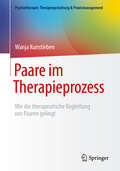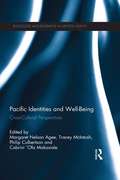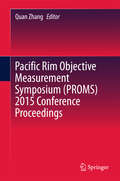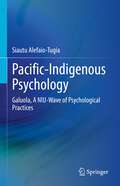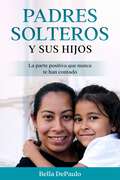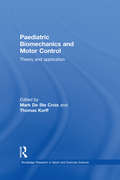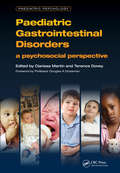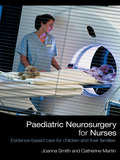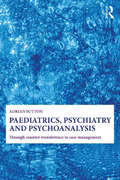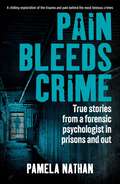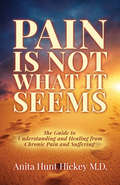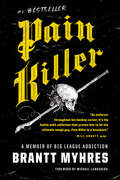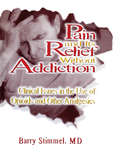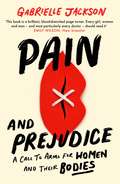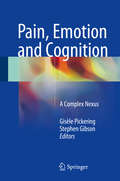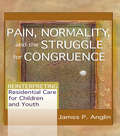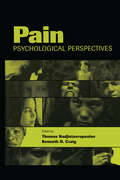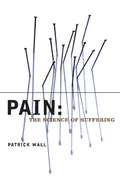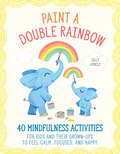- Table View
- List View
Paare im Therapieprozess: Wie die therapeutische Begleitung von Paaren gelingt (Psychotherapie: Therapiegestaltung & Praxismanagement)
by Wanja KunstlebenDieses Buch ist für Sie als Therapeut und Therapeutin eine essentielle Stütze, um heikle Momente, eskalierende Konflikte und komplexe Dynamiken in der Arbeit mit Paaren souverän zu meistern. Der Autor stellt ein klares und effizientes Modell zur Navigation und Prozesssteuerung von Paartherapien vor. So finden Sie Orientierung und Steuerungskompetenz in diesem hochdynamischen Setting und können mit Selbstvertrauen Therapiesitzungen sicher gestalten und leiten. Das schulenübergreifende Modell gliedert sich in 3 Prozess-Dimensionen: Regulation, Klärung und Intimität. Anschaulich und nah am Erleben in der Praxis wird aufgezeigt, wie Sie als Therapeut oder Therapeutin sicher erkennen, um welche Prozessebene es in der Arbeit mit dem Paar gerade geht. Anhand von Beispielen, praktischen Übungen und einem breiten Spektrum an Methoden wird verständlich, wie Sie darauf antworten können. Lernen Sie, wie Sie spielerisch von einem Prozess-Modus in den anderen wechseln und Sie Ihre therapeutische Rolle flexibel anpassen. So können Sie sich und Ihre Klienten und Klientinnen entlasten und kompetent begleiten. Das Modell kann für die sichere Gestaltung von Paarsitzungen im Rahmen von Einzeltherapien ebenso genutzt werden wie für Paarberatungen und Paartherapien. Es besticht durch seine Klarheit und Effizienz und seinen hohen Wiedererkennungswert in der therapeutischen Arbeit. Dabei integriert der Autor verschiedene Ansätze und führt Sie wohlwollend und ermutigend durch das Modell und die Dynamiken von Paartherapien. Geraten Sie auch in herausfordernden Situationen nicht ins Schwimmen, sondern behalten den Überblick mit diesem hilfreichen Navigationstool!
Pacific Identities and Well-Being: Cross-Cultural Perspectives (Routledge Monographs in Mental Health)
by Philip Culbertson Margaret Nelson Agee Tracey McIntosh Cabrini 'Ofa MakasialeFilling a significant gap in the cross-cultural and cross-disciplinary literature within the field of Pasifika (Polynesian) and Maori identities and mental health, this volume focuses on bridging mental health related research and practice within the indigenous communities of the South Pacific. Much of the content reflects both differences from and relationships with the dominant Western theories and practices so often unsuccessfully applied with these groups. The contributors represent both experienced researchers and practitioners and address topics such as research examining traditional and emerging Pasifika identities; contemporary research and practice in working with Pasifika youth and adolescents; culturally-appropriate approaches for working with Pasifika adults; and practices in supervision that have been developed by Maori and Pasifika practitioners. Chapters include practice scenarios, research reports, analyses of topical issues, and discussions about the appropriateness of applying Western theory in other cultural contexts. As Pasifika cultures are still primarily oral cultures, the works of several leading Maori and Pasifika poets that give voice to the changing identities and contemporary challenges within Pacific communities are also included.
Pacific Rim Objective Measurement Symposium (PROMS) 2015 Conference Proceedings
by Quan ZhangThis book collects and organizes the original studies presented at PROMS 2015 conference on theories and applications of Rasch model. It provides useful examples of the Rasch model used to address practical measurement problems across a range of different disciplines including Item Response Theory (IRT), philosophy of measurement, dimensionality, the role of fit statistics and residuals, application, educational application, language testing, health-related research, business and industrial application and Rasch-based computer software. PROMS 2015 (Pacific Rim Objective Measurement Symposium) was held from August 20-24th 2015, in Fukuoka, Japan. The goal of this conference is to bring together the researchers from academia, universities, hospitals, industry, management sector as well as practitioners to share ideas, problems and solutions relating to the multifaceted aspects of Rasch Model.
Pacific-Indigenous Psychology: Galuola, A NIU-Wave of Psychological Practices
by Siautu Alefaio-TugiaThis book provides an overview of Pacific-Indigenous knowledge as insights of Oceanic citizen-science to inform culturally-safe practice for psychology. It profiles contemporary Pacific needs in areas of crisis such as family violence, education disparities and health inequities, and points to ancient Pacific-indigenous knowledges as tools of healing for global diasporic communities in need. The historical evolution of psychology’s knowledge base and practice illustrates a fundamental crisis in the method of producing knowledge for psychology - the absence of Pacific-indigenous cultural knowledge. It suggests more effective research methodologies grounded in Pacific-Indigenous epistemologies and ontologies for psychology and overall community capability. It fosters practice perspectives and strategies based on NIU-psychology (New Indigenous Understandings) for innovative solutions to modern-day crises of humanity.
Pack Elsa Punset (2 ebooks): Inocencia radical y Brújula para navegantes emocionales
by Elsa PunsetElsa Punset, experta en inteligencia emocional, nos ayuda a entender nuestras emociones, a enfrentarlas y a transformarlas en nuevas oportunidades de cambio. Elsa Punset nos habla en este pack del impacto de las emociones en la vida diaria. «Siempre quise arrancar las emociones del campo académico, de la fría disección, para llevarlas a las manos de las personas, a la vida real, al interior de cada uno de nosotros. Porque allí es donde importan, traspasan, duelen y transforman. Las emociones son el lenguaje universal con el cual sentimos, nos comunicamos, nos amamos o nos odiamos. Tenemos que lograr descifrarlas, amaestrarlas, disfrutarlas sin temor». Este pack contiene los títulos:- INOCENCIA RADICAL- BÚJULA PARA NAVEGANTES EMOCIONALES Inocencia radical:Nacemos inocentes, vulnerables, curiosos, dotados de la pasión por vivir. Cómo nos enfrentamos a estas etapas cruciales de nuestra existencia determinará el tejido de nuestras emociones. Elsa Punset nos alienta en Inocencia radical a sacar provecho de nuestra capacidad innata para amar y para transformar. Brújula para navegantes emocionales:En los últimos tiempos las emociones, gracias a las puertas abiertas por la neurociencia, pueden catalogarse, comprenderse e incluso gestionarse: son la llave de nuestro centro neurálgico. Conocerse a uno mismo permite descubrir las fuentes de nuestra felicidad, nuestra ira y nuestro dolor para poder convivir armoniosa y plenamente con nosotros mismos y con los demás.
Padres solteros y sus hijos: La parte positiva que nunca te han contado
by Bella DePauloPadres solteros y sus hijos es una recopilación de artículos que desmiente todos los estereotipos que desprecian y degradan a las familias monoparentales. Basándose en la investigación científica más rigurosa, la Dra. Bella DePaulo demuestra que las pésimas predicciones respecto al destino de los hijos de las familias monoparentales son exageradas o simplemente erróneas. Es más, hay aspectos en los que los hijos de padres solteros se desenvuelven mejor que los demás. Esta es la parte positiva que nunca te han contado.
Paediatric Biomechanics and Motor Control: Theory and Application (Routledge Research in Sport and Exercise Science)
by Mark De Ste Croix Thomas KorffPaediatric Biomechanics and Motor Control brings together the very latest developmental research using biomechanical measurement and analysis techniques and is the first book to focus on biomechanical aspects of child development. The book is divided into four main sections – the biological changes in children; developmental changes in muscular force production; developmental changes in the biomechanics of postural control and fundamental motor skills and finally the applications of research into paediatric biomechanics and motor control in selected clinical populations. Written by a team of leading experts in paediatric exercise science, biomechanics and motor control from the UK, the US, Australia and Europe, the book is designed to highlight the key implications of this work for scientists, educators and clinicians. Each chapter is preceded by a short overview of the relevant theoretical concepts and concludes with a summary of the practical and clinical applications in relation to the existing literature on the topic. This book is important reading for any sport or exercise scientist, health scientist, physical therapist, sports coach or clinician with an interest in child development or health.
Paediatric Gastrointestinal Disorders: A Psychosocial Perspective
by Clarissa MartinThe medical specialty of paediatric gastroenterology is focused on problems and disorders within the gastrointestinal tract, liver and pancreas of children from infancy until age eighteen. This inspirational compilation provides information on current research and clinical practice regarding the psychosocial aspects of paediatric gastrointestinal c
Paediatric Neurosurgery for Nurses: Evidence-based care for children and their families
by Joanna Smith Catherine MartinPaediatric Neurosurgery for Nurses: Evidence-based care for children and their families provides accessible and up-to-date information for nurses working in paediatric neurosurgery. Referring throughout to the evidence-base for care and interventions, this complex area is described and explained in a meaningful and easily understandable way. The text includes chapters on the underpinning knowledge and principles for the care of children who need neurosurgery as well as the following common neurological problems: Hydrocephalus Traumatic Brain Injury Craniosynostosis Brain Tumours Surgical management of epilepsy in children Cerebrovascular disorders Neural tube defects The complexity of the nervous system and principles of care are presented logically with points to consider and essential care clearly highlighted and, where available, evidence-based practice is presented. It includes a range of pedagogical features, such as chapter overviews and summaries, diagrams, sample care plans, text boxes and a glossary. This book is essential reading for pre-registration nursing students and newly qualified nurses but will also be of use to allied healthcare professionals working with children and young people requiring neurosurgery.
Paediatrics, Psychiatry and Psychoanalysis: Through counter-transference to case management
by Adrian SuttonHow do children and parents shape clinical practice? How can clinicians learn from the impact of their patients upon them? How do we recognise if health care practices are adversely affecting health care? Children's health problems can place enormous strain on both children and their families. Whether symptoms are acute or chronic, assessment and treatment can be confusing and frightening even when the illness itself is not dangerous. Understanding the impact of illness on emotions, relationships and development is an essential part of providing good health care services. For health care professionals it is necessary to understand how their clinical practice affects their patients and how this reciprocal relationship shapes good or bad practice. Introducing key psychoanalytic concepts Adrian Sutton illustrates through detailed clinical studies how psychoanalytic theory can be applied in a health care setting involving children and their families. Paediatrics, Psychiatry and Psychoanalysis specifically describes the impact of the patient on the professional, how conscious and unconscious elements need to be taken into account, and to what extent these can influence practice enhancing diagnostic and therapeutic treatment. Paediatrics, Psychiatry and Psychoanalysis is an exploration of the central importance of the patient-doctor relationship and how the psychodynamics of this relationship are crucial in providing information that can aid treatment. It will be of interest to child mental health professionals – psychoanalysts, psychotherapists, psychiatrists, psychologists, nurses, paediatric practitioners and those working in social welfare and educational settings.
Paedophiles in Society
by Sarah D. GoodeAcademic and cultural understandings of paedophilia tend to diverge into a 'sexual liberation' discourse and a 'child protection' discourse, each missing important insights from the other. This book goes beyond radical and conservative debates to set out a new understanding, arguing that paedophiles are not 'outside' culture or society but are part of our everyday human existence - and that sexual attraction to children is part of human sexuality. Firmlyplacing the needs and wellbeing of children first, Sarah Goode's work is a challenging and thought-provoking response to contemporary anxieties over paedophilia and child sexual abuse. It addresses the need for information on paedophiles which does not assume that they are monsters, mad, evil or 'other' and which seeks to locate paedophiles in their everyday context, in society, arguing that thesenew understandingsoffer new ways to protect children from harm. "
Pain Bleeds Crime: Stories from a forensic psychologist in prisons and out.
by Pamela Nathan"The most dangerous people I met weren&’t monsters. They were broken children wearing adult faces." ________________________________________Pamela Nathan, clinical and forensic psychologist and psychoanalytic psychotherapist, uncovers the inner worlds of society&’s most dangerous and broken—whether behind bars or hidden in plain sight. In Pain Bleeds Crime, she shares twenty-three gripping true stories from her decades working in maximum-security prisons, courts, and forensic hospitals. The crimes are shocking—murder, rape, paedophilia, assault, fetishism, bestiality, and more—but what lies beneath is often even more confronting. Each offender, whether male, female or transgender, reveals a hidden world shaped by trauma, pain, and silence. Pamela enters these inner worlds to feel and then to have revealed the internal crime scenes, to see what made them break—mentally, emotionally, morally. These aren&’t excuses. They&’re revelations. You&’ll come face-to-face with people whose crimes horrified the public—people who insist they&’re not violent, or that &“it just happened&”—and come face-to-face with the dark truth: the past never really goes away. With unflinching honesty and rare insight, Pamela shows how the past never really stays buried—and how behind every act of violence, there&’s a story waiting to be told. Brutally honest, deeply unsettling, and impossible to forget, Pain Bleeds Crime is a journey into the darkest parts of humanity."Mad, bad, or sad—when we listen to the story, we see the person." "A chilling exploration of the trauma and pain behind the most heinous crimes."
Pain Is Not What It Seems: The Guide to Understanding and Healing from Chronic Pain and Suffering
by Anita Hunt HickeyPain is Not What it Seems contains a treasure trove of scientific references supporting an astonishingly simple and transformative path to healing and well-being. While conventional Western medicine tends to treat the body and mind as separate entities, scientific evidence proves that physical, spiritual, and psychological aspects of self can affect one another on a profound level. Pain Is Not What It Seems explains the science that tells us that only when these deeper spiritual and emotional issues are addressed can true healing from suffering and pain begin. After thirty years treating military and civilian patients with chronic and acute pain and associated disorders, Dr. Hickey has shared profound wisdom and insights of the “secrets” behind how to heal from intractable complex pain, which—although published in scientific journals and books—is not taught to most doctors nor found in standard wellness curriculums. Her astonishingly simple and transformative program provides an easy-to-follow path to healing from suffering and pain that reaffirms what those suffering realize intrinsically: they are a whole person and need to be treated as such.
Pain Killer: A Memoir of Big League Addiction
by Brantt Myhres"This book is at times startling, yet very real and down to earth . . . I saw [Brantt] in all phases of his life and his career. I consider him a friend and an ally. Pain Killer sends a strong message." --Darryl Sutter, former NHL player, coach, and GMFrom the only player to be banned for life from the NHL, a harrowing tale of addiction, and an astonishing path to recovery.Brantt Myhres wasn't around for the birth of his daughter. Myhres had played for seven different NHL teams, and had made millions. But he'd been suspended four times, all for drug use, and he had partied his way out of the league. By the time his daughter was born, he was penniless, sleeping on a friend's couch. He'd just been released from police custody. He had a choice between sticking around for the birth, or showing up for league-mandated rehab. He went to rehab. For the fifth time.This is his story, in his own words, of how he fought his way out of minor hockey into the big league, but never left behind the ghosts of a bleak and troubled childhood. He tells the story of discovering booze as a way of handling the anxiety of fighting, and of the thrill of cocaine. In the raw language of the locker room, he tells of how substance abuse poisoned the love he had in his life and sabotaged a great career. Full of stories of week-long benders, stripper-filled hot tubs, motorcycle crashes, and barroom brawls, Pain Killer is at its most powerful when Myhres acknowledges how he let himself down, and betrayed those who trusted him. Again and again, he fools the executives and doctors who gave him a second chance, then a third, then a fourth, and with each betrayal, he spirals further downward.But finally, on the eve of his daughter's birth, when all the money was gone, every bridge burnt, and every opportunity squandered, he was given a last chance. And this time, it worked.It worked so well, that not only has he been around for his daughter for the past eleven years, in 2015 he was signed by the LA Kings as a "sober coach": a guy who'd been there, a guy who could recognize and help solve problems before they ruined lives and made headlines (as the Kings had seen happen three times that season). Not only did Myhres save himself, he saved others. Unpolished, unpretentious, and unflinching, Myhres tells it like it is, acknowledging every mistake, and painting a portrait of an angry, violent, dangerous man caught in the vice of something he couldn't control, and didn't understand. If Brantt Myhres can pull himself together, anyone can. And he does, convincingly, and inspiringly.
Pain and Emotion in Modern History
by Rob BoddiceDrawing on the expertise of historical, literary and philosophical scholarship, practicing physicians, and the medical humanities this is a true interdisciplinary collaboration, styled as a history. It explores pain at the intersection of the living, suffering body, and the discursive cultural webs that entangle it in its specific moment.
Pain and Its Relief Without Addiction: Clinical Issues in the Use of Opioids and Other Analgesics
by Barry StimmelPain and Its Relief Without Addiction will help people in pain understand why their pain is not always adequately relieved, as well as help reverse the failure of current medical practice to routinely alleviate pain. As noted by a 1992 publication of the United States Department of Health Services, this devastating trend contributes to unnecessary discomfort, longer recovery periods, and compromised patient outcomes. By reading this book, frustrated physicians and, perhaps more importantly, persons in pain can acquire a better understanding of the nature of pain, its connection to the emotions and psychological state of patients, and the impact particular drugs have on the body; this will facilitate relief from pain among a higher percentage of the population.Opioid analgesics comprise many of the chapters in Pain and Its Relief Without Addiction. Author Barry Stimmel, MD, describes the principles to be followed in prescribing opioid analgesics to relieve pain while maintaining one’s daily activities without any limitation in function. The available opioids are described, and the differences between them are reviewed to allow you--as a physician, health care provider, or even a patient--to gain a better insight into the one(s) to use for both acute and chronic pain states. The point that is emphasized is that dependency on an analgesic to relieve pain is no different than dependency on medications to lower blood pressure, prevent heart attacks, treat diabetes, etc. What should be avoided is “addiction,” a condition where function is impaired rather than enhanced.Pain and Its Relief Without Addiction is a guidebook designed to assist physicians and other health professionals in developing a practical approach to pain management and to give patients a fuller understanding of their pain. You’ll gain specific information about: management of acute and chronic pain pain in children pain and cancer pain and AIDS psychological support of persons in pain theories of pain perception the anatomy of painIn Pain and Its Relief Without Addiction, you’ll learn the basic concepts of drug dependence, tolerance, and withdrawal, the pharmacological actions and side effects of drugs used to provide analgesia, and the fundamental steps to be taken in proper pharmacological treatment of pain. The book produces more effective and more informed communication among physicians, other health professionals, and patients so that together they can achieve better pain relief. As Pain and Its Relief Without Addiction illustrates, it is crucial that both patients and physicians understand clearly the terms describing drug use and the behavioral, biochemical, and cellular concepts underlying dependence, tolerance, and withdrawal. Finally, you will acquire a knowledge of all the potential causes of pain and the appropriate steps for intervention.Medical students, new practitioners, and those wishing to reconsider their approaches to pain management will benefit from the book’s coverage of general principles for pain control, the use of drug combinations to provide the most effective relief, methods for treating pain in different populations (such as the elderly and persons with chronic medical conditions), and alternative options for failed treatment. The scope of Pain and Its Relief Without Addiction reaches from nonprescription medications, such as aspirin, to NSAIDS, like ibuprofen, to narcotic analgesics to stimulants such as amphetamines and caffeine. It is the most comprehensive book available on various drugs, their desired effects and side effects, and their use to alleviate pain.
Pain and Prejudice: A call to arms for women and their bodies
by Gabrielle JacksonAn incredibly important and powerful look at how our culture treats the pain and suffering of women in medical and social contexts. A polemic on the state of women's health and healthcare.One in ten women worldwide have endometriosis, yet it is funded at 5% of the rate of diabetes; women are half as likely to be treated for a heart attack as men and twice as likely to die six months after discharge; over half of women who are eventually diagnosed with an autoimmune disease will be told they are hypochondriacs or have a mental illness. These are just a few of the shocking statistics explored in this book.Fourteen years after being diagnosed with endometriosis, Gabrielle Jackson couldn't believe how little had changed in the treatment and knowledge of the disease. In 2015, her personal story kick-started a worldwide investigation into the disease by the Guardian; thousands of women got in touch to tell their own stories and many more read and shared the material. What began as one issue led Jackson to explore how women - historically and through to the present day - are under-served by the systems that should keep them happy, healthy and informed about their bodies.Pain and Prejudice is a vital testament to how social taboos and medical ignorance keep women sick and in anguish. The stark reality is that women's pain is not taken as seriously as men's. Women are more likely to be disbelieved and denied treatment than men, even though women are far more likely to be suffering from chronic pain.In a potent blend of polemic and memoir, Jackson confronts the private concerns and questions women face regarding their health and medical treatment. Pain and Prejudice, finally, explains how we got here, and where we need to go next.
Pain and Prejudice: A call to arms for women and their bodies
by Gabrielle JacksonAn incredibly important and powerful look at how our culture treats the pain and suffering of women in medical and social contexts. A polemic on the state of women's health and healthcare.One in ten women worldwide have endometriosis, yet it is funded at 5% of the rate of diabetes; women are half as likely to be treated for a heart attack as men and twice as likely to die six months after discharge; over half of women who are eventually diagnosed with an autoimmune disease will be told they are hypochondriacs or have a mental illness. These are just a few of the shocking statistics explored in this book.Fourteen years after being diagnosed with endometriosis, Gabrielle Jackson couldn't believe how little had changed in the treatment and knowledge of the disease. In 2015, her personal story kick-started a worldwide investigation into the disease by the Guardian; thousands of women got in touch to tell their own stories and many more read and shared the material. What began as one issue led Jackson to explore how women - historically and through to the present day - are under-served by the systems that should keep them happy, healthy and informed about their bodies.Pain and Prejudice is a vital testament to how social taboos and medical ignorance keep women sick and in anguish. The stark reality is that women's pain is not taken as seriously as men's. Women are more likely to be disbelieved and denied treatment than men, even though women are far more likely to be suffering from chronic pain.In a potent blend of polemic and memoir, Jackson confronts the private concerns and questions women face regarding their health and medical treatment. Pain and Prejudice, finally, explains how we got here, and where we need to go next.
Pain, Emotion and Cognition
by Gisèle Pickering Stephen GibsonThis book focuses on the reciprocal interactions between pain, emotion and cognition. International experts report on their findings, clinical experience and the most recent literature on the complex relations between these three domains. Clinical, psychological, behavioral and neuroimaging approaches converge towards aiding patients suffering from pain, cognitive impairment or emotional distress. Beyond the pathophysiological aspects of pain, difficulties encountered with patients are analyzed and strategies are proposed to optimize treatment, doctor-patient relationships, and patient well-being. This work will appeal to a broad readership, from clinical medical practitioners to psychologists, nurses and pain specialists.
Pain, Normality, and the Struggle for Congruence: Reinterpreting Residential Care for Children and Youth
by James P AnglinLearn what children living in group homes need most! Pain, Normality, and the Struggle for Congruence: Reinterpreting Residential Care for Children and Youth presents the results of a 14-month study of 10 staffed group homes in British Columbia. The book uses grounded theory to construct a theoretical model that speaks to the primary challenge care workers face each day-responding to pain and pain-based behavior in residents. It combines participant observations, transcribed interviews, and document analysis to develop a core theme of congruence, several major psychosocial processes, and 11 interactional dynamics identified as being fundamental to group home life. The study brings to light several neglected aspects of residential care and proposes new directions in policy development, education, practice, and research to create an integrated and accessible framework for understanding group home life for youths. Pain, Normality, and the Struggle for Congruence: Reinterpreting Residential Care for Children and Youth is a full and rigorous examination of the theoretical and empirical underpinnings of residential group care. The study-conducted during a time of heightened sensitivity to the rights of children and increased emphasis on accountability and outcome measurement-reveals a core theme of congruence, focusing on consistency, reciprocity, and coherence. The book examines the major elements of this theme, including: creating an extra-familial living environment developing a sense of normality listening and responding with respect establishing a structure, routine, and expectations offering emotional and developmental support respecting personal space and time discovering potential communicating a framework for understanding and much more! Pain, Normality, and the Struggle for Congruence: Reinterpreting Residential Care for Children and Youth provides professionals concerned with the development and treatment of children and young people with a unique understanding of group home life and work. From the Foreword, by Dr. Barney Glaser: I am honored and delighted to be asked by Jim Anglin to write the foreword to this grounded theory text... The purpose of this grounded theory is to construct a theoretical framework that would explain and account for well-functioning staffed group homes for young people, that in turn could serve as a basis for improved practice, policy development, education and training, research, and evaluation. THE READER WILL SEE THAT ANGLIN HAS ACHIEVED HIS GOAL WITH ADMIRABLE SUCCESS. . . . HIS GROUNDED THEORY TRULY MAKES A SCHOLARLY CONTRIBUTION TO THE LITERATURE.
Pain: Psychological Perspectives
by Kenneth D. Craig Thomas HadjistavropoulosThis invaluable resource presents a state-of-the-art account of the psychology of pain from leading researchers. It features contributions from clinical, social, and biopsychological perspectives, the latest theories of pain, as well as basic processes and applied issues. The book opens with an introduction to the history of pain theory and the epidemiology of pain. It then explores theoretical work, including the gate control theory/neuromatrix model, as well as biopsychosocial, cognitive/behavioral, and psychodynamic perspectives. Issues, such as the link between psychophysiological processes and consciousness and the communication of pain are examined. Pain over the life span, ethno-cultural, and individual differences are the focus of the next three chapters. Pain: Psychological Perspectives addresses current clinical issues:* pain assessment and acute and chronic pain interventions;* the unavailability of psychological interventions for chronic pain in a number of settings, the use of self-report, and issues related to the implementation of certain biomedical interventions; and * the latest ethical standards and the theories.Intended for practitioners, researchers, and students involved with the study of pain in fields such as clinical and health psychology, this book will also appeal to physicians, nurses, and physiotherapists. Pain is ideal for advanced courses on the psychology of pain, pain management, and related courses that address this topic.
Pain: The Science of Suffering (Maps of the Mind)
by Patrick WallPain is one of medicine's greatest mysteries. When farmer John Mitson caught his hand in a baler, he cut off his trapped hand and carried it to a neighbor. "Sheer survival and logic" was how he described it. "And strangely, I didn't feel any pain." How can this be? We're taught that pain is a warning message to be heeded at all costs, yet it can switch off in the most agonizing circumstances or switch on for no apparent reason. Many scientists, philosophers, and laypeople imagine pain to operate like a rigid, simple signaling system, as if a particular injury generates a fixed amount of pain that simply gets transmitted to the brain; yet this mechanistic model is woefully lacking in the face of the surprising facts about what people and animals do and experience when their bodies are damaged. Patrick Wall looks at these questions and sets his scientific account in a broad context, interweaving it with a wealth of fascinating and sometimes disturbing historical detail, such as famous characters who derived pleasure from pain, the unexpected reactions of injured people, the role of endorphins, and the power of placebo. He covers cures of pain, ranging from drugs and surgery, through relaxation techniques and exercise, to acupuncture, electrical nerve stimulation, and herbalism. Pain involves our state of mind, our social mores and beliefs, and our personal experiences and expectations. Stepping beyond the famous neurologic gate-control theory for which he is known, Wall shows that pain is a matter of behavior and its manifestation differs among individuals, situations, and cultures. "The way we deal with pain is an expression of individuality."
Paint a Double Rainbow: 40 Mindfulness Activities for Kids and Their Grown-Ups to Feel Calm, Focused, and Happy
by Sally ArnoldYou and Your Child: Be Mindful TogetherMindfulness reduces anxiety and stress, improves focus and concentration, and creates calm--all attributes parents want for their kids. But what happens if you don't know how to practice mindfulness yourself? How do you teach it to your child?Paint a Double Rainbow provides 40 mindfulness activities for you and your child to do together, so you both reap the benefits as you develop a deeper connection. Whether you're savoring silent sandwiches, sharing moonlight gratitudes, or taking a chalk walk, this charming book helps you develop a mindful toolbox, incorporate mindfulness into your daily lives, and create deep and lasting bonds. Together, you can have fun exploring... • A QUICK GUIDE TO MINDFULNESS and its benefits • 40 FUN ACTIVITIES to practice mindfulness • STRESS- AND ANXIETY BUSTERS through breathing, strengthening your senses, focusing, being kind, imagining, and relaxing With this playful book, you and your child will discover how mindfulness for kids can transform your lives.
Paintracking: Your Personal Guide to Living Well With Chronic Pain
by Deborah BarrettMillions of people suffer from debilitating chronic pain from arthritis, fibromyalgia, low back pain, chronic headache syndromes, neuropathies, or other painful conditions. People contending with chronic pain often spend considerable time, energy, and money searching for answers and visit multiple doctors, trying anything to find relief. When the source of pain is unclear or difficult to diagnose, their experiences are additionally frustrating, exhausting, and depressing. This book offers a hands-on approach to improving life with chronic pain, whatever the underlying cause. As a sociologist, psychotherapist, and someone with firsthand experience with chronic pain, the author understands the challenges that accompany pain and has devised realistic strategies to fare better. Paintracking provides a systematic method that empowers individuals to navigate the otherwise overwhelming array of treatment options and incorporate the effective ones into their lives for continued, incremental progress. Its cornerstone is a self-study tool that enables readers to improve. Readers are instructed on how to track and interpret their experience, whether using a pen and paper or the online tool offered as a companion to the book. By cultivating awareness of how their body responds in different situations and to different therapies, readers will become capable self-advocates, able to make informed choices. Written in clear, understandable prose and filled with sociological insights, therapeutic lessons, practical tips, and empathy, this book offers realistic hope to individuals who often feel hopeless in the face of confusing, debilitating pain.
Pais à maneira dinamarquesa
by Jessica Alexander Iben Dissing SandahlO que sabem as pessoas mais felizes do mundo sobre como educar crianças confiantes e capazes O que faz da Dinamarca o país mais feliz do mundo? E quais são os segredos dos pais dinamarqueses para criarem crianças bem-sucedidas, confiantes e felizes? Este guia optimista e prático reúne as ideias de uma psicoterapeuta e de uma mãe - uma dinamarquesa e uma americana casada com um dinamarquês, respectivamente - sobre os hábitos das famílias mais felizes na Terra. O livro oferece conselhos sobre como: - Incentivar jogos livres - Potenciar a autenticidade e a confiança - Fomentar a empatia - Enfatizar o trabalho em equipa sobre as lutas de poder - Comemorar a união Com tópicos práticos e exemplos inspiradores, Pais à Maneira Dinamarquesa ajudará os pais e educadores a tornar as crianças mais felizes e mais bem integradas. «Um poderoso novo método de educar crianças "resilientes e seguras em termos emocionais" - por outras palavras, exactamente aquilo que todos procuramos.»Revista Mother «Se os "adultos" de todos os países pusessem em prática os princípios delineados em A Maneira Dinamarquesa nem que fosse em 50 por cento das suas vidas, oh, o potencial para mudar a humanidade [...] Por vezes um livro tem o poder de remodelar literalmente o mundo tal como o conhecemos, provocando mudanças na próxima geração que poderão até fazer com que a palavra guerra se torne um conceito do passado difuso e distante. Pais à Maneira Dinamarquesa é, verdadeiramente, uma Bíblia para todos os adultos."The Glass House Girls «A cozinha nórdica, o design nórdico, o noir nórdico - a lista de exportações culturais de sucesso tem sido interminável, ao longo da última década, e agora podemos acrescentar-lhe a Educação Nórdica [...] Dir-se-ia que as mães dinamarquesas é que têm razão.»The Post (Copenhaga) «A pesquisa e a honesta reflexão de Alexander sobre como a sua própria prática parental tem sido influenciada e melhorada pela cultura dinamarquesa do marido, é um valioso recurso para quaisquer pais que procurem reflectir a respeito das vulnerabilidades no seu próprio estilo de parentalidade. A pesquisa de Sandahl, e a sua experiência pessoal e profissional como mãe dinamarquesa e psicoterapeuta, reforçam a ideia de que os dinamarqueses têm, de facto, um brilhante talento natural para criar miúdos resilientes e equilibrados. Juntas, as autoras criam um guia parental escrito com ponderação, encorajando a auto-reflexão e oferecendo conselhos úteis sobre como melhor abordar os mais comuns desafios da parentalidade. Pais à Maneira Dinamarquesa é de leitura obrigatória para os pais originários de qualquer cultura.Carolyn Rathjen, MSW, LICSW
